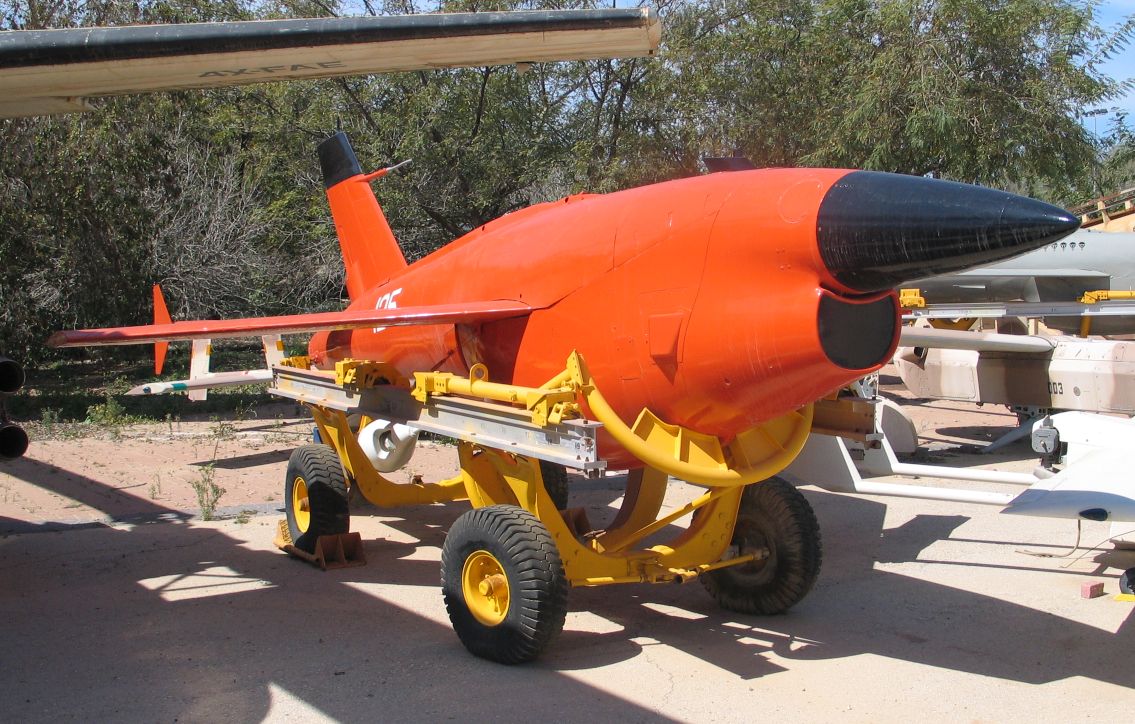|
Globe KD2G Firefly
The Globe KD2G Firefly was a pulsejet-powered American target drone, built by the Globe Aircraft Corporation for operation by the United States Navy in the late 1940s, seeing operational use into the mid-1950s. Design and development The KD2G was a mid-wing, twin-tailed aircraft of similar design to the KDG Snipe which Globe was already supplying to the Navy. A single McDonnell PJ42 pulsejet engine was mounted atop the rear of the fuselage.Parsch 2005 The fuselage was constructed of steel tubing with a duralumin monocoque covering; dural was also used for the flying surfaces. The KD2G was equipped with radio control with an effective range of ; it could be launched using a catapult, or launched aerially from JD-1 or F7F-2D aircraft. Recovery, if it survived its mission, was by a diameter parachute; the Firefly was designed to be able to float for up to 15 minutes in the event of a water landing. Operational history First flying as the XKD2G-1 prototype during 1946, the KD2 ... [...More Info...] [...Related Items...] OR: [Wikipedia] [Google] [Baidu] |
Target Drone
A target drone is an unmanned aerial vehicle, generally remote controlled, usually used in the training of anti-aircraft crews. One of the earliest drones was the British DH.82 Queen Bee, a variant of the Tiger Moth trainer aircraft operational from 1935. Its name led to the present term "drone". In their simplest form, target drones often resemble radio-controlled model aircraft. More modern drones may use countermeasures, radar, and similar systems to mimic manned aircraft. More advanced drones are made from large, older missiles which have had their warheads removed. In the United Kingdom, obsolete Royal Air Force and Royal Navy jet and propeller-powered aircraft (such as the Fairey Firefly, Gloster Meteor and de Havilland Sea Vixen used at RAE Llanbedr between the 1950s and 1990s) have also been modified into remote-controlled drones, but such modifications are costly. With a much larger budget, the U.S. military has been more likely to convert retired aircraft or olde ... [...More Info...] [...Related Items...] OR: [Wikipedia] [Google] [Baidu] |
Grumman F7F Tigercat
The Grumman F7F Tigercat is a heavy fighter aircraft that served with the United States Navy (USN) and United States Marine Corps (USMC) from late in World War II until 1954. It was the first twin-engine fighter to be deployed by the USN. While the Tigercat was delivered too late to see combat in World War II, it saw action as a night fighter and attack aircraft during the Korean War. Designed initially for service on ''Midway''-class aircraft carriers, early production F7Fs were land-based variants. The type was too large to operate from older and smaller carriers, and only a late variant (F7F-4N) was certified for carrier service. Design & development Based on the earlier Grumman XP-50 that was eventually canceled, the company developed the XP-65 (Model 51) further for a future "convoy fighter" concept. In 1943, work on the XP-65 was terminated in favor of the design that would eventually become the F7F.Dorr and Donald 1990, p. 119. The contract for the prototype XF7F-1 wa ... [...More Info...] [...Related Items...] OR: [Wikipedia] [Google] [Baidu] |
Mid-wing Aircraft
A monoplane is a fixed-wing aircraft configuration with a single mainplane, in contrast to a biplane or other types of multiplanes, which have multiple planes. A monoplane has inherently the highest efficiency and lowest drag of any wing configuration and is the simplest to build. However, during the early years of flight, these advantages were offset by its greater weight and lower manoeuvrability, making it relatively rare until the 1930s. Since then, the monoplane has been the most common form for a fixed-wing aircraft. Characteristics Support and weight The inherent efficiency of the monoplane is best achieved in the cantilever wing, which carries all structural forces internally. However, to fly at practical speeds the wing must be made thin, which requires a heavy structure to make it strong and stiff enough. External bracing can be used to improve structural efficiency, reducing weight and cost. For a wing of a given size, the weight reduction allows it to fly slower a ... [...More Info...] [...Related Items...] OR: [Wikipedia] [Google] [Baidu] |
1940s United States Special-purpose Aircraft
Year 194 ( CXCIV) was a common year starting on Tuesday (link will display the full calendar) of the Julian calendar. At the time, it was known as the Year of the Consulship of Septimius and Septimius (or, less frequently, year 947 ''Ab urbe condita''). The denomination 194 for this year has been used since the early medieval period, when the Anno Domini calendar era became the prevalent method in Europe for naming years. Events By place Roman Empire * Emperor Septimius Severus and Decimus Clodius Septimius Albinus Caesar become Roman Consuls. * Battle of Issus: Septimius Severus marches with his army (12 legions) to Cilicia, and defeats Pescennius Niger, Roman governor of Syria. Pescennius retreats to Antioch, and is executed by Severus' troops. * Septimius Severus besieges Byzantium (194–196); the city walls suffer extensive damage. Asia * Battle of Yan Province: Warlords Cao Cao and Lü Bu fight for control over Yan Province; the battle lasts for over 100 days ... [...More Info...] [...Related Items...] OR: [Wikipedia] [Google] [Baidu] |
Globe Aircraft
A globe is a spherical model of Earth, of some other celestial body, or of the celestial sphere. Globes serve purposes similar to maps, but unlike maps, they do not distort the surface that they portray except to scale it down. A model globe of Earth is called a terrestrial globe. A model globe of the celestial sphere is called a ''celestial globe''. A globe shows details of its subject. A terrestrial globe shows landmasses and water bodies. It might show nations and major cities and the network of latitude and longitude lines. Some have raised relief to show mountains and other large landforms. A celestial globe shows notable stars, and may also show positions of other prominent astronomical objects. Typically, it will also divide the celestial sphere into constellations. The word ''globe'' comes from the Latin word ''globus'', meaning "sphere". Globes have a long history. The first known mention of a globe is from Strabo, describing the Globe of Crates from about 150 ... [...More Info...] [...Related Items...] OR: [Wikipedia] [Google] [Baidu] |
List Of Unmanned Aerial Vehicles
The following is a list of unmanned aerial vehicles developed and operated in various countries around the world. Algeria * AL fajer L-10 * Amel (UAV) Argentina * AeroDreams Chi-7 ( AeroDreams) * AeroDreams Strix Reconnaissance (2006) * AeroVision Arcangel (AeroVision) - agricultural and civilian surveillance (2010) * FMA IA X 59 Dronner ( FAdeA) - reconnaissance (1972) * Lipán M3 "Apache" - reconnaissance (2007) * Lipán XM4 - reconnaissance (development) * ARA Guardian (UAV) - reconnaissance (2007) * Nostromo Caburé ( Nostromo Defensa) * Nostromo Centinela * Nostromo Yarará2009 Worldwide UAV Roundup Poster . ''Aerospace America''. April 2009. * Nostromo Yagua * Quimar MQ-2 "Bigua" < ... [...More Info...] [...Related Items...] OR: [Wikipedia] [Google] [Baidu] |
Radioplane Q-1
The Radioplane Q-1 was an American target drone, developed in the early 1950s for the United States Air Force by the Radioplane Company. Originally powered by a pulsejet engine, then later developed as an improved turbojet-powered aircraft, the Q-1 failed to win the favor of the USAF. However, the aircraft provided the basis of the GAM-67 Crossbow anti-radar missile. Design and development Shortly after its formation in 1948, the United States Air Force issued a specification calling for a new type of high-speed target drone. Required to be jet-powered to provide the most realistic training, the contract for the development of the drone was given to the Radioplane Company, later a division of Northrop. Powered by a single Giannini PJ39 pulsejet engine, the drone, given the designation RP-26 by the company and XQ-1 by the USAF, was a high-wing, rocket sled launched aircraft. Originally fitted with a large single vertical stabiliser, the design was modified to a twin tail configu ... [...More Info...] [...Related Items...] OR: [Wikipedia] [Google] [Baidu] |
Naval Aircraft Modification Unit KDN Gorgon
The Naval Aircraft Modification Unit KDN Gorgon, originally designated TD2N, was an early jet-powered target drone developed by the Bureau of Aeronautics and constructed by the Naval Aircraft Modification Unit for use by the United States Navy. First flown near the end of World War II, it was cancelled due to problems with its engine in 1946. Development The TD2N-1 was a development of the Gorgon IIIB missile, designed in 1943 by the U.S. Navy Bureau of Aeronautics for use against heavy bomber aircraft and ground targets using optical guidance.Parch 2005 The Gorgon IIIB was cancelled due to its engine proving unsatisfactory;Leyes and Fleming 1999, p.42. however, a version simplified for use as a target drone was developed starting in November 1944. Built by the Navy's Naval Aircraft Modification Unit, located in the former Brewster Aeronautical Corporation factory in Johnsville, Pennsylvania,Pattillo 1998, p.145 the TD2N-1 was of conventional design, with a monoplane wing and tw ... [...More Info...] [...Related Items...] OR: [Wikipedia] [Google] [Baidu] |
McDonnell TD2D Katydid
The McDonnell TD2D Katydid was a pulsejet-powered American target drone produced by McDonnell Aircraft that entered service with the United States Navy in 1942, and continued in use until the late 1940s. History In March 1941, the U. S. Navy awarded McDonnell Aircraft a contract for a radio-controlled target drone under the designation of XTD2D-1 for anti-aircraft and aerial gunnery practice. The aircraft had a mid-mounted wing, V-tail, and McDonnell XPJ40-MD-2 pulsejet engine mounted atop the rear fuselage. The drone could be either launched by catapult from the ground or from underwing racks on Consolidated PBY Catalina flying boats. It was gyro-stabilized, and control was by radio command; at the end of its mission the drone could be recovered by parachute. Operational history The Katydid entered service in 1942; testing took place at the Naval Air Missile Test Center in Point Mugu, California. Production models were originally designated TD2D-1, however the Navy changed ... [...More Info...] [...Related Items...] OR: [Wikipedia] [Google] [Baidu] |
Globe KD3G Snipe
The Globe KDG Snipe was an American target drone, built by the Globe Aircraft Corporation for use by the United States Navy. The KDG, and its modified version, the KD3G Snipe, served between 1946 and the early 1950s. Design and development The KDG Snipe was a small, mid-winged target drone,Grossnick and Armstrong 1997, p.669. operated by radio control. The Snipe was designed to be launched by use of a catapult system; if the aircraft was not destroyed during its mission, it would deploy a parachute for recovery.Parsch 2003 The KDG was powered by a McCulloch 4300 two-stroke engine; an improved version, designated KD3G, was powered by a Kiekhaefer O-45 opposed piston engine An opposed-piston engine is a piston engine in which each cylinder has a piston at both ends, and no cylinder head. Petrol and diesel opposed-piston engines have been used mostly in large-scale applications such as ships, military tanks, and f .... Operational history The Snipe entered service with the U ... [...More Info...] [...Related Items...] OR: [Wikipedia] [Google] [Baidu] |





